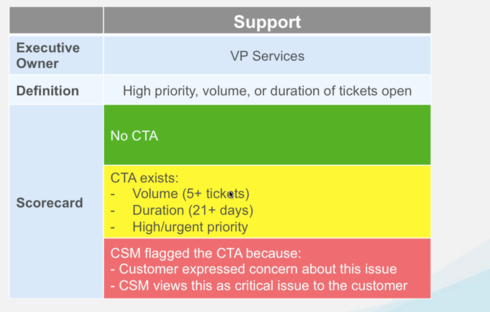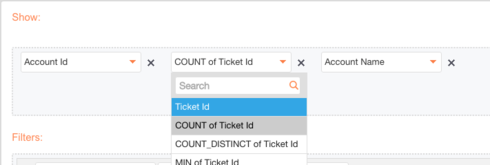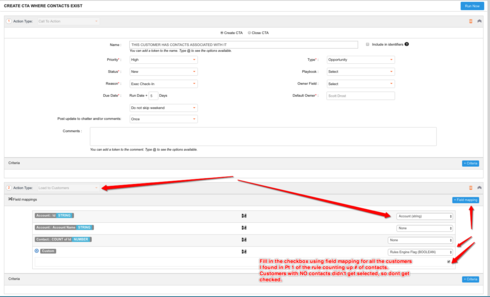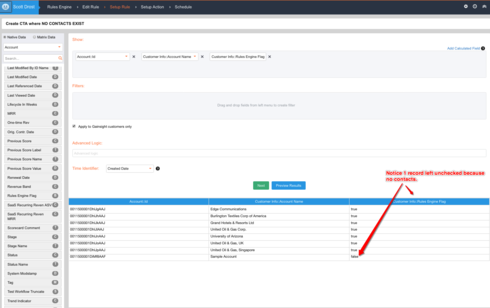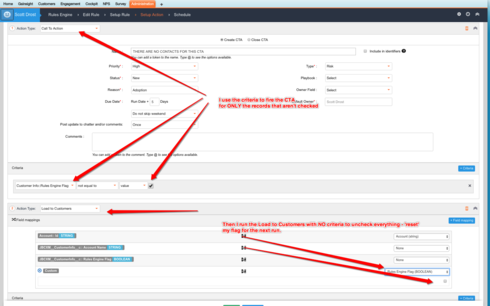Can't create "No CTA" rule to raise health score
I'm sure many of you have attended the Express workshop and/or webinars and therefore will find this next graphic familiar...
The problem I'm having is I can't seem to put together a simple rule to indicate that no CTA's exist. When I came across this problem my first instinct was to place the following in the filter field:
CTA type includes Risk
Count of CTA equals 0
But I realized that we cannot pivot around "count" when an object is in the "filter" field of a rule, however we can pivot around "count" in the "show" field as shown below...
So my question to anyone else who's run into this same issue before, how did you structure your rule to indicate that no risk CTA's exist? I've created a work around but it's not sufficient. I had to create a rule that says "if a Risk CTA exists AND open tasks equals zero THEN set score to Green". I won't get into the different reasons on why this isn't a sufficient work around, but nevertheless I wanted to share and see if anyone else had this issue and found a successful work around for it.
To any employees who are reading this, is there a reason we can't select count when an object is in the filter field? It seems as though it would make sense to have that ability.
The problem I'm having is I can't seem to put together a simple rule to indicate that no CTA's exist. When I came across this problem my first instinct was to place the following in the filter field:
CTA type includes Risk
Count of CTA equals 0
But I realized that we cannot pivot around "count" when an object is in the "filter" field of a rule, however we can pivot around "count" in the "show" field as shown below...
So my question to anyone else who's run into this same issue before, how did you structure your rule to indicate that no risk CTA's exist? I've created a work around but it's not sufficient. I had to create a rule that says "if a Risk CTA exists AND open tasks equals zero THEN set score to Green". I won't get into the different reasons on why this isn't a sufficient work around, but nevertheless I wanted to share and see if anyone else had this issue and found a successful work around for it.
To any employees who are reading this, is there a reason we can't select count when an object is in the filter field? It seems as though it would make sense to have that ability.
My understanding of the best practices (and the way I've set up our own instance) is to have a crop of rules that run first thing in the morning to reset all health scores to green or N/A, as appropriate for each score. Then, you have your rules run that will set the scores to yellow or red.
For what it's worth, the reason it isn't doable is that you'd be telling Gainsight to:
There's no way in Gainsight's "Setup Rule" interface to say "Find me all the data for all accounts, then compare that with all the data for open Risk CTAs, and keep only the Account data where there are zero open Risk CTAs." (If you're familiar with SQL: that would require a "left outer join", but Gainsight's interface only does "inner joins".)
- Find me all the data on open Risk CTAs
- Count up how many of them there are for each Account
- Now show me only the records where there are zero Risk CTAs
There's no way in Gainsight's "Setup Rule" interface to say "Find me all the data for all accounts, then compare that with all the data for open Risk CTAs, and keep only the Account data where there are zero open Risk CTAs." (If you're familiar with SQL: that would require a "left outer join", but Gainsight's interface only does "inner joins".)
We are working and plan to add this capability to set a rule that would support the "absence of data" condition. For now, the workaround suggested by Seth works - you have a "reset" rule that runs before your evaluation rule that sets the scorecard value to the default that exists for "no data/no CTA". So for Support Risk, that is Green; for sentiment, we set it to Yellow (no promoters or detractors or no NPS at all)
You could also write a couple rules to help. First, you would need to create a field for number of open/closed CTAs that would load the count of how many open/closed CTAs. You would then need to write a rule to populate this field on the cadence you would like (Weekly, daily, monthly). Next, you would need to write a rule that would run right before this one to write 0 for each customer. When the rule runs to load how many there have been, it will only write to those that have had one.
Then you can pull into the scorecard any that have 0.
Then you can pull into the scorecard any that have 0.
Would this effect the historical tracking of scorecards? From what I can tell, every day the previous score value/label would be green, so it would show a daily shift of green -> yellow/red for accounts that are yellow/red.
I would go Lane's route but I need scorecards live ASAP and we have a 3 week release cycle on SFDC fields.
I would go Lane's route but I need scorecards live ASAP and we have a 3 week release cycle on SFDC fields.
Hi Scott,
When you set up your historical scorecard snapshotting, there is a specific time of the day and week that the scorecard gets stored. (Documentation here: https://support.gainsight.com/hc/en-us/articles/202987566-Configure-Scorecard-History-) So, the score can swing wildly this-and-that'a'way between the snapshots, and the only thing that matters is where the score is [i]when the snapshot is taken.
In our case, our scorecard snapshots are only stored weekly. So, Gainsight doesn't end up showing the score as shifting versus the most recent historical snapshot, even though, early every morning, some scores are set from Red or Yellow, to Green or N/A, and then back to Red or Yellow. If you score your snapshots daily or more frequently, I imagine you could take advantage of the same approach, if you're just more thoughtful than I need to be about exactly what time of day those score-setting rules run.
When you set up your historical scorecard snapshotting, there is a specific time of the day and week that the scorecard gets stored. (Documentation here: https://support.gainsight.com/hc/en-us/articles/202987566-Configure-Scorecard-History-) So, the score can swing wildly this-and-that'a'way between the snapshots, and the only thing that matters is where the score is [i]when the snapshot is taken.
In our case, our scorecard snapshots are only stored weekly. So, Gainsight doesn't end up showing the score as shifting versus the most recent historical snapshot, even though, early every morning, some scores are set from Red or Yellow, to Green or N/A, and then back to Red or Yellow. If you score your snapshots daily or more frequently, I imagine you could take advantage of the same approach, if you're just more thoughtful than I need to be about exactly what time of day those score-setting rules run.
Hi Seth/Lane,
I just realized that our version of historical tracking was set up by my administrative predecessor and is different than default historical tracking provided by Gainsight.
We have tens of thousands of accounts and 5 planned scorecards, which would take up a huge amount of Salesforce storage, and we are already close to our limit. To circumvent this he had written out rules to load historical scorecard data to MDA.
I dug into our rules and it doesn't look like this will be an issue, as it captures the historical data in a similar snapshot fashion on a weekly basis.
Thank you both for your insight.
I just realized that our version of historical tracking was set up by my administrative predecessor and is different than default historical tracking provided by Gainsight.
We have tens of thousands of accounts and 5 planned scorecards, which would take up a huge amount of Salesforce storage, and we are already close to our limit. To circumvent this he had written out rules to load historical scorecard data to MDA.
I dug into our rules and it doesn't look like this will be an issue, as it captures the historical data in a similar snapshot fashion on a weekly basis.
Thank you both for your insight.
Hello all -
There's another way that I prefer when setting these up for customers, but you do have to have the flexibility to add a Checkbox field to the Customer Info. The process works because rule Actions run in the order shown in the rule itself. Basically, here's what I do for these "absence of detail records" requirements where setting everything to the "0" value first isn't desired:
1. Add a checkbox field to Customer Info - I typically call it "Rules Engine Flag" and use it for multiple purposes. Make sure that it is set to "false" (unchecked) for everything.
2. Create the first rule to set the score for all customers where there are records (CTA's, opportunities, whatever detail object you are looking for). Set your scores, then add a "Load to Customers" action that fills in the checkbox for everything you just selected and scored.
3. Now you have a bunch of customers left with unchecked boxes - these are the customers that didn't have any detail records. With your 2nd rule, SELECT ALL CUSTOMERS (don't filter by checkbox yet).
a. Set the score for the 'leftover' customers by adding a criteria filter to the action for Checkbox = 'blank'
b. Add a 2nd action that unchecks ALL boxes with Load to Customer - this will "reset" your flag field for the next 2-rule series that you can run on anything you like.
c. Schedule these rules 1 minute apart so they run in order, but you don't let any other rules "in between" them.
Screenshots below - hope that helps!
RULE # 1 - CREATE CTA (or in your case, set scores) FOR ALL CUSTOMERS WITH CONTACT RECORDS, AND CHECK
THOSE BOXES OFF FOR THE GROUP:
RULE #2 (2 screenshots): SELECT ALL CUSTOMERS AND PUT YOUR CHECKBOX IN 'SHOW' SO YOU CAN FILTER IN ACTION FOR YOUR SCORE-SETTING, THEN UNCHECK EVERYTHING ('RESET'):
There's another way that I prefer when setting these up for customers, but you do have to have the flexibility to add a Checkbox field to the Customer Info. The process works because rule Actions run in the order shown in the rule itself. Basically, here's what I do for these "absence of detail records" requirements where setting everything to the "0" value first isn't desired:
1. Add a checkbox field to Customer Info - I typically call it "Rules Engine Flag" and use it for multiple purposes. Make sure that it is set to "false" (unchecked) for everything.
2. Create the first rule to set the score for all customers where there are records (CTA's, opportunities, whatever detail object you are looking for). Set your scores, then add a "Load to Customers" action that fills in the checkbox for everything you just selected and scored.
3. Now you have a bunch of customers left with unchecked boxes - these are the customers that didn't have any detail records. With your 2nd rule, SELECT ALL CUSTOMERS (don't filter by checkbox yet).
a. Set the score for the 'leftover' customers by adding a criteria filter to the action for Checkbox = 'blank'
b. Add a 2nd action that unchecks ALL boxes with Load to Customer - this will "reset" your flag field for the next 2-rule series that you can run on anything you like.
c. Schedule these rules 1 minute apart so they run in order, but you don't let any other rules "in between" them.
Screenshots below - hope that helps!
RULE # 1 - CREATE CTA (or in your case, set scores) FOR ALL CUSTOMERS WITH CONTACT RECORDS, AND CHECK
THOSE BOXES OFF FOR THE GROUP:
RULE #2 (2 screenshots): SELECT ALL CUSTOMERS AND PUT YOUR CHECKBOX IN 'SHOW' SO YOU CAN FILTER IN ACTION FOR YOUR SCORE-SETTING, THEN UNCHECK EVERYTHING ('RESET'):
Reply
Sign up
If you ever had a profile with us, there's no need to create another one.
Don't worry if your email address has since changed, or you can't remember your login, just let us know at community@gainsight.com and we'll help you get started from where you left.
Else, please continue with the registration below.
Welcome to the Gainsight Community
Enter your username or e-mail address. We'll send you an e-mail with instructions to reset your password.

